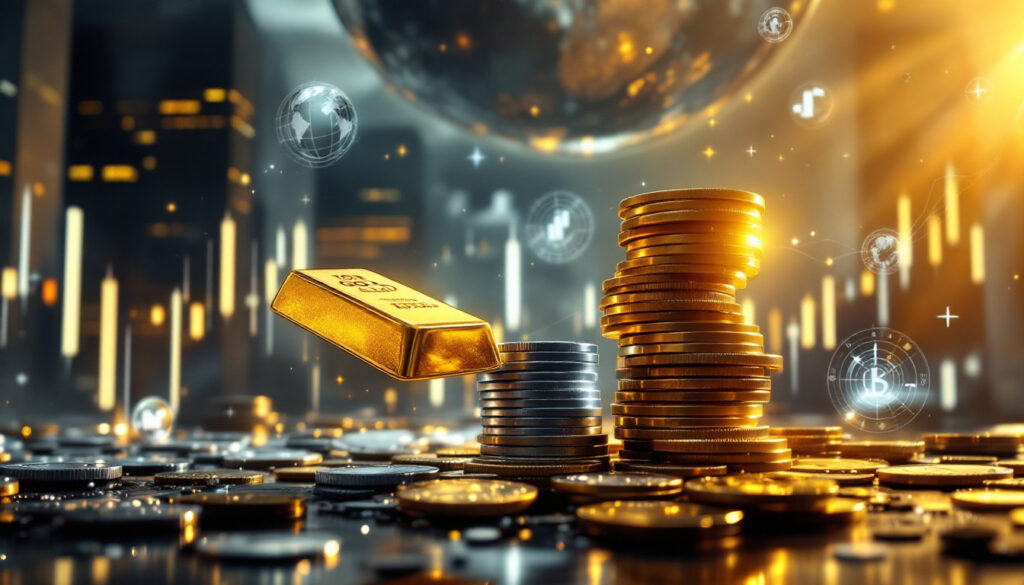What Is the Gold to Silver Ratio?
The gold to silver ratio is a fundamental metric in precious metals investing, representing how many ounces of silver it takes to purchase a single ounce of gold. As of April 4, 2025, this ratio stands at an extraordinary 102.5:1, meaning investors need over 102 ounces of silver to equal the value of just one ounce of gold. This relationship between the two precious metals reveals important market dynamics and can guide strategic investment decisions.
Definition and Historical Context
The gold to silver ratio has fluctuated significantly throughout history, reflecting changing economic conditions and market sentiment. The current 102:1 ratio represents an extreme level by historical standards, approaching the levels seen during the height of market panic in March 2020, when the ratio hit an unprecedented 111.97:1 during COVID-related market turmoil.
Before the pandemic, the ratio typically ranged lower, hitting approximately 79:1 during the 2008 financial crisis before dramatically dropping to 35:1 in 2011 when silver approached $50 per ounce. These historical benchmarks provide context for today's elevated ratio and suggest potential for mean reversion.
Throughout much of recorded history, the ratio was much lower, averaging between 15:1 and 30:1 during centuries when silver played a more prominent role in monetary systems. The modern average over the past century hovers around 50:1, making the current 102:1 level particularly noteworthy to investors and analysts alike.
How the Ratio Is Calculated
Calculating the gold to silver ratio involves a straightforward division:
Gold to Silver Ratio = Gold Price per Ounce ÷ Silver Price per Ounce
For example, on April 4, 2025, with gold at $3,061 per ounce and silver at $29.99 per ounce, the calculation yields 102.15 as the ratio.
This mathematical relationship has practical physical implications. Currently, one standard ounce gold coin equals the value of approximately 102 ounces of silver—visualized as one kilogram bar, one twenty-ounce bar, and five ten-ounce bars combined. This disparity in physical volume highlights the substantial valuation gap between these two precious metals.
Recent Price Movements in Precious Metals
The precious metals market has experienced significant volatility in recent weeks, with divergent performance across metals pointing to complex underlying market dynamics.
Silver's Dramatic Price Drop
Silver has undergone a particularly severe correction, plummeting from $34.12 on March 28, 2025, to $29.99 by April 4, 2025. The most dramatic portion of this decline occurred in just two days between April 2-4, when silver shed 12.03% of its value.
This sharp decline erased months of gains, with silver falling below its price from one month prior ($31.98 on March 4, 2025). The extreme volatility in silver markets became evident even during market analysis, with prices changing significantly within 45-minute periods—a characteristic reminder of silver's reputation for rapid price swings.
The magnitude of silver's decline stands out even more when compared to its historical volatility patterns, suggesting potential capitulation selling or structural shifts in demand forecasts for the metal.
Gold's Relative Stability
In stark contrast to silver's performance, gold demonstrated remarkable resilience during the same period. While still registering a decline, gold dropped only 2.33% during the critical two-day window that saw silver plunge over 12%.
Gold traded at approximately $3,070 per ounce as of April 4, 2025. Unlike silver, gold maintained its position above its price from the previous month ($2,918 on March 4, 2025), preserving a 5.2% monthly gain despite the recent pullback.
This divergence in performance—with gold maintaining relative strength while silver collapsed—provides compelling evidence of gold's role as a monetary hedge in 2024 during periods of market uncertainty.
Comparative Performance of Precious Metals
The recent market action affected the entire precious metals complex, but with varying severity:
| Metal | 2-Day Price Drop (April 2-4, 2025) |
|---|---|
| Silver | 12.03% |
| Gold | 2.33% |
| Platinum | 4.79% |
| Palladium | 4.63% |
This performance disparity reveals important insights about market perception of these metals. While all precious metals declined, silver's outsized drop suggests factors beyond those affecting the broader precious metals sector. Gold's modest decline relative to other metals reinforces its premier status as a store of value during market stress.
Why Is Silver Underperforming Gold?
Several factors help explain silver's dramatic underperformance relative to gold, reflecting fundamental differences in how markets value these metals.
Industrial vs. Precious Metal Dynamics
Silver's dual identity as both precious and industrial metal creates unique market dynamics. Unlike gold, which primarily serves as a monetary metal and store of value, silver faces demand fluctuations tied to industrial production cycles.
Approximately 56% of silver demand stems from industrial applications—including electronics, photovoltaics, and medical technology—compared to less than 10% for gold. This industrial exposure makes silver particularly vulnerable to economic slowdown concerns or manufacturing disruptions.
During economic uncertainty, investors often prioritize gold's monetary properties over silver's hybrid role, contributing to widening gold-silver ratios during market stress. The current 102:1 ratio reflects this flight to gold's perceived safety over silver's industrial risk exposure.
Tariff Exclusion Impact
A significant catalyst for silver's recent underperformance appears linked to trade policy developments. Both gold and silver received exclusions from upcoming tariffs, removing a potential price pressure that market participants had previously factored into their trading decisions.
Industry experts suggest silver prices had become artificially inflated due to anticipated tariffs, with industrial users potentially stockpiling material in anticipation of higher future costs. When these tariffs were excluded, the speculative premium rapidly evaporated from silver prices.
The tariff exclusion eliminated a key near-term catalyst for higher silver prices, triggering selling pressure from industrial users who no longer feared immediate supply cost increases. This development demonstrates how policy changes can create asymmetric impacts across the precious metals complex.
Dollar Index (DXY) Relationship
The Dollar Index (DXY) dropped from approximately 104 on April 2, 2025, to around 102.5 by April 4, 2025. Traditionally, precious metals prices exhibit an inverse relationship with the dollar—rising when the dollar weakens and falling when it strengthens.
Silver's failure to follow this established pattern despite the dollar's decline suggests other, more powerful market forces overwhelmed this typical correlation. This correlation breakdown indicates that industrial demand concerns or positioning adjustments outweighed traditional monetary factors in determining silver's price trajectory.
The divergence between silver and the dollar index represents an unusual market condition that often precedes significant repricing events or signals the influence of non-monetary factors on precious metals markets.
How to Take Advantage of the High Gold to Silver Ratio
The extreme 102:1 gold-silver ratio presents potential opportunities for strategic investors willing to position for potential mean reversion.
Trading Strategies During High Ratios
When the gold-silver ratio reaches historically elevated levels, experienced precious metals investors often consider trading gold for silver to capitalize on eventual ratio normalization. This approach leverages the mathematical advantages of ratio reversion.
Consider this practical example: An investor trading 2 ounces of gold for silver at the current 102:1 ratio would receive approximately 204 ounces of silver. If the ratio eventually returns to more moderate historical levels—perhaps 70:1—those 204 ounces could theoretically be converted back to 2.91 ounces of gold, representing a 31.4% increase in gold holdings.
This strategy requires careful timing and patience, potentially involving holding periods of 12-18 months based on historical precedent. Investors should remember that while ratios above 100:1 have historically been unsustainable, timing the precise reversion remains challenging.
Potential Scenarios for Ratio Normalization
The gold-silver ratio can normalize through several distinct scenarios:
-
Silver price increases while gold remains stable – This represents the optimal scenario for ratio traders, where silver outperforms while gold preserves value.
-
Gold price decreases while silver remains stable – A less favorable scenario where ratio improvement comes through gold depreciation rather than silver appreciation.
-
Both metals move, but silver appreciates more rapidly than gold – The most common historical pattern, where both metals respond to market conditions but with silver exhibiting greater percentage moves.
Historical precedent strongly suggests ratios above 100:1 represent unsustainable extremes that eventually revert toward long-term averages. Previous instances of ratios exceeding 100 have typically been followed by significant silver outperformance within 6-18 months.
Premium Considerations
Successful ratio trading requires accounting for transaction costs and dealer premiums. The spread between buying and selling prices—particularly for physical metals—can significantly impact strategy profitability.
Investors must calculate whether premium differences exceed potential ratio advantages. For example, if dealer buy/sell spreads total 7%, the ratio would need to compress by more than this percentage to generate profit.
Seeking dealers offering competitive spreads specifically for ratio trading can enhance potential returns. Some specialty dealers even offer dedicated ratio trading programs that minimize these transaction costs for 2024 gold ETF strategies.
FAQ About the Gold to Silver Ratio
What is considered a "normal" gold to silver ratio?
The concept of "normal" for the gold-silver ratio has evolved throughout history. During periods when both metals were used as currency, the ratio often ranged between 12:1 and 15:1, reflecting their natural geological abundance ratio of approximately 17:1 in the Earth's crust.
In the modern financial era, the average over the last century approximates 50:1, with the recent decade typically ranging between 60:1 and 80:1 during normal market conditions. The extreme outliers include the 35:1 ratio during silver's 2011 peak near $50/oz and the 112:1 ratio during March 2020's COVID-19 panic.
Analysts generally consider ratios above 80:1 as historically elevated and potentially favorable for silver, while ratios below 40:1 may signal relative silver overvaluation. For a detailed historical analysis, the gold-silver ratio charts provide valuable perspective on these long-term trends.
How does the ratio help with investment timing?
The gold-silver ratio serves as a valuable timing indicator for precious metals investors. High ratios (above 80:1) historically signal potential silver buying opportunities or favorable conditions for trading gold into silver.
Conversely, low ratios (below 50:1) may indicate advantageous conditions for converting silver holdings to gold, effectively "trading up" to capture silver's outperformance.
These ratio extremes often precede significant market corrections or realignments, making them useful indicators for contrarian investors seeking to position ahead of potential mean reversion. The ratio proves most valuable at its extremes, serving as a measurement of relative value rather than absolute price prediction.
How quickly can the gold to silver ratio change?
The gold-silver ratio can shift with remarkable speed during periods of market volatility. Historical examples demonstrate ratio changes of 20-30 points within several months during major market dislocations.
As noted in recent market action, significant ratio movements can occur within extremely compressed timeframes—even within a single trading day during periods of exceptional volatility. The transcript specifically mentions observable price changes within a 45-minute period, highlighting silver's notorious price volatility.
Major economic announcements, central bank policy shifts, or geopolitical developments can trigger rapid ratio changes by disproportionately affecting one metal over the other. Silver's smaller market size makes it particularly susceptible to sharp price swings that quickly alter the ratio calculation.
Is the gold to silver ratio a reliable indicator?
The gold-silver ratio functions best as one tool among many for investment decisions rather than as a standalone indicator. Its reliability increases at extreme readings (very high or very low) where mean reversion pressures build.
Investors should consider the ratio alongside other economic indicators, technical analysis, and broader market conditions. The ratio proves most useful for relative value assessment between the two metals rather than as an absolute price predictor.
Historical analysis shows the ratio has limited predictive power for short-term moves but substantial value for identifying potential medium-term opportunities. The ratio's most reliable signal occurs when it reaches historical extremes, as with the current 102:1 level, which has typically preceded significant mean reversion.
Market Implications of the Current Ratio
What the 102:1 Ratio Signals About Market Sentiment
The extraordinary 102:1 gold-silver ratio reveals several important market dynamics and investor preferences. Most notably, it signals extreme investor preference for gold's monetary and safe-haven properties over silver's industrial exposure during uncertain economic conditions.
This ratio suggests possible industrial demand concerns for silver, potentially reflecting manufacturing slowdown fears or reduced technological demand projections. The market's willingness to value gold at 102 times silver's price per ounce represents a significant premium for perceived safety and liquidity.
From an efficiency perspective, such extreme ratios often indicate potential market inefficiencies that tend to correct over time. Historical precedent strongly suggests ratios above 100:1 represent unsustainable extremes rarely maintained for extended periods.
Broader Market Context
The precious metals volatility exists within a context of broader market weakness. The transcript notes investment portfolios declining approximately 5.2% during the same week, suggesting correlated risk-off behavior across multiple asset classes.
Particularly noteworthy is the unusual behavior of precious metals declining despite dollar weakness (DXY dropping from 104 to 102.5). This correlation breakdown represents atypical market conditions that often precede significant repricing events across asset classes.
The precious metals complex shows internal divergence, with gold demonstrating relative resilience (-2.33%) compared to silver (-12.03%), platinum (-4.79%), and palladium (-4.63%). This performance disparity suggests investors discriminating between metals based on monetary versus industrial properties, which aligns with insights from recent gold market analysis for 2024-2025.
Long-Term Investment Considerations
Silver's greater volatility presents both higher risk and potential reward compared to gold. While silver has historically experienced more severe drawdowns during market stress, it has also delivered superior percentage gains during bull markets.
The principle of mean reversion suggests the current 102:1 ratio likely represents a temporary extreme rather than a new paradigm. Throughout history, previous instances of ratios exceeding 100 have typically been followed by significant silver outperformance within 6-18 months.
Industrial demand factors will likely influence silver's recovery timeline, particularly developments in renewable energy (photovoltaics), electronics manufacturing, and medical technology. Silver's industrial applications account for approximately 56% of demand, making economic growth projections critical to its price trajectory. Understanding these factors requires a deeper look at gold price drivers and economic impact alongside 2024 gold and silver market trends.
For those interested in tracking these relationships, the Investopedia analysis of gold-silver ratio trading provides additional insights on how professional investors approach these opportunities.
Important Note: The content in this article is for informational purposes only and should not be considered financial advice. Consult with a professional financial advisor before making investment decisions.
Ready to Invest in the Next Major Mining Discovery?
Discover significant ASX mineral announcements before the market with Discovery Alert's proprietary Discovery IQ model, turning complex data into actionable insights for both short-term traders and long-term investors. Explore why historic discoveries generate substantial returns by visiting Discovery Alert's dedicated discoveries page and begin your 30-day free trial today.




